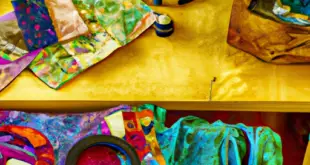Crafting your own textiles can be a rewarding and fulfilling experience that allows you to unleash your creativity and create unique designs. In this article, we will explore the world of DIY screen printing and block printing techniques, two popular methods for creating custom textiles.
Whether you’re a seasoned artist or a beginner, these techniques offer endless possibilities for expressing your individuality and adding a personal touch to your fabrics.
Screen printing is a versatile technique that involves transferring ink onto a fabric through a mesh screen. This method allows for intricate designs and vibrant colors, making it a favorite among artists and designers.
Block printing, on the other hand, involves carving a design onto a block of wood or linoleum and using it to stamp the pattern onto the fabric. This technique offers a more organic and rustic feel, perfect for those who appreciate a handmade aesthetic.
Both screen printing and block printing can be done at home with minimal equipment, making them accessible to anyone interested in creating their own textiles.
So, whether you’re looking to revamp your wardrobe, decorate your home, or give a unique gift, join us as we delve into the world of DIY screen printing and block printing techniques, and discover the endless possibilities they offer.
Understanding Screen Printing Techniques
Screen printing techniques can be better understood by examining the step-by-step process involved in creating designs using stencils and applying ink through a mesh screen onto various materials.
The process begins with the creation of a stencil, which can be made from a variety of materials such as paper, plastic, or even metal. This stencil is then attached to a mesh screen, which acts as a barrier to prevent the ink from passing through the areas that are not part of the design.
Once the stencil is secured onto the screen, ink is applied to one end of the screen and a squeegee is used to push the ink across the screen, forcing it through the open areas of the stencil and onto the desired material.
The beauty of screen printing lies in its versatility and ability to produce intricate designs with precision. By using different stencils and adjusting the ink application, artists can create a wide range of effects, from bold and vibrant prints to subtle and delicate patterns.
Furthermore, screen printing allows for the use of various types of inks, including metallic, fluorescent, and even glow-in-the-dark, adding another layer of creativity to the process. Whether it’s printing on fabric, paper, or even wood, screen printing offers endless possibilities for artists and designers to express their creativity and bring their visions to life.
Exploring Block Printing Methods
Utilizing traditional methods, individuals can explore various techniques for creating intricate designs through the art of block printing.
Block printing is a technique that involves carving a design into a block of material, such as wood, linoleum, or rubber, and then transferring that design onto fabric or paper.
The process begins with the creation of a design, which is then transferred onto the block.
The carver then carefully carves away the negative space, leaving behind the raised design.
Ink is applied to the surface of the block, and a piece of fabric or paper is pressed onto it.
The pressure transfers the ink onto the fabric or paper, creating a print of the design.
Block printing allows for a wide range of creativity and experimentation.
Different types of blocks and materials can be used to achieve different effects.
For example, a softer material like linoleum or rubber may be used for more intricate designs, while a harder material like wood may be used for bolder, more graphic prints.
Additionally, various carving techniques can be employed to create different textures and patterns.
This versatility allows artists to explore and push the boundaries of their designs, creating unique and innovative prints.
Whether it’s creating bold geometric patterns or intricate floral designs, block printing provides endless possibilities for individuals looking to express their creativity through textiles.
Choosing the Right Materials and Tools
When selecting the appropriate materials and tools for block printing, artists must carefully consider their desired effects and the level of intricacy in their designs. The choice of materials and tools will greatly influence the outcome of the print, and it is important to choose ones that are suitable for the specific design and desired effects.
For example, when it comes to the block itself, artists can choose from various materials such as linoleum, wood, or even rubber. Linoleum blocks are often preferred for their ease of carving and durability, while wood blocks offer a traditional and organic feel. Rubber blocks, on the other hand, are a popular choice for beginners due to their flexibility and ease of use.
The type of ink used is also crucial in achieving the desired effects. Water-based inks are commonly used for block printing as they are non-toxic, easy to clean, and offer a wide range of colors. However, oil-based inks can provide a richer and more vibrant color, although they require longer drying times and may be more difficult to clean.
Apart from the materials, artists must also consider the tools they will use for carving and printing. Carving tools come in various shapes and sizes, and the choice will depend on the intricacy of the design and the desired level of detail. V-shaped gouges are commonly used for creating fine lines and details, while U-shaped gouges are ideal for clearing large areas. It is important to choose tools that are comfortable to hold and maneuver, as block printing can be a time-consuming process.
When it comes to printing, a brayer or roller is essential for evenly distributing the ink on the block. Soft rubber brayers are often preferred, as they provide better control and coverage. Additionally, artists may also need a baren or a wooden spoon for applying pressure to transfer the ink onto the paper.
Overall, selecting the right materials and tools for block printing is crucial in achieving the desired effects and ensuring a successful print. By carefully considering the intricacy of the design and the desired outcome, artists can create unique and innovative prints that showcase their creativity and craftsmanship.
Creating Unique Designs and Patterns
To create truly unique designs and patterns in block printing, artists must carefully consider their desired effects and experiment with different materials and techniques.
Block printing allows for endless possibilities in design, as artists can create intricate patterns and textures by carving into a block of material. By using various tools and techniques such as linocut or woodcut, artists can achieve different effects in their prints. They can experiment with different types of blocks, such as linoleum or wood, each offering its own unique qualities and texture. Additionally, artists can play with different inks, colors, and mixing techniques to further enhance their designs.
By exploring different combinations of materials and techniques, artists can push the boundaries of traditional block printing and create innovative and captivating designs.
In addition to materials and techniques, artists can also draw inspiration from various sources to create unique designs and patterns. They can explore different themes, such as nature, geometry, or cultural symbols, to bring depth and meaning to their prints. Artists can also experiment with different composition techniques, such as layering or repetition, to add visual interest and complexity to their designs. Furthermore, artists can incorporate their own personal style and artistic vision into their prints, allowing for a truly individualized and innovative approach.
By combining different elements and techniques, artists can create prints that are not only visually appealing but also tell a story or evoke certain emotions. Through careful experimentation and a subconscious desire for innovation, artists can push the boundaries of block printing and create truly unique and captivating designs.
Conclusion
In conclusion, screen printing and block printing are two fascinating techniques that allow individuals to create their own unique textiles. By understanding the principles and methods behind these techniques, one can explore a world of possibilities in textile design.
From creating intricate patterns to printing on various materials, the possibilities are endless.
When it comes to screen printing, it is important to have a clear understanding of the process and the materials involved. By carefully selecting the right tools and materials, one can achieve professional-looking results. Additionally, block printing offers a more hands-on approach, allowing for a more tactile and organic feel in the designs.
Choosing the right materials and tools is crucial in both screen printing and block printing. From selecting the right fabric and ink to using the appropriate screens or blocks, each element plays a role in the final outcome of the printed textile. By experimenting with different materials and tools, individuals can discover their own unique style and create one-of-a-kind designs.
Creating unique designs and patterns is the essence of textile printing. By exploring different techniques and experimenting with various patterns, individuals can unleash their creativity and bring their ideas to life. Whether it’s through screen printing or block printing, there are endless possibilities for creating visually stunning textiles.
In conclusion, DIY screen printing and block printing techniques offer a world of creative possibilities for individuals who are passionate about textile design. By understanding the principles and methods behind these techniques, choosing the right materials and tools, and unleashing their creativity, individuals can craft their own unique textiles that reflect their personal style and vision.
So why wait? Start exploring the world of textile printing today and let your imagination run wild.
 printablelabelstemplate
printablelabelstemplate
